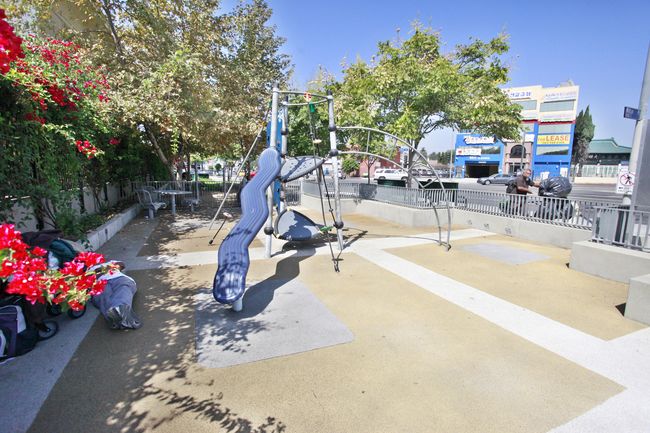
Los Angeles City Council President Herb Wesson has long been encouraging further development plans in Koreatown, as his hope is to liken the city’s densest neighborhood to New York City’s iconic Manhattan borough.
However, Koreatown still largely remains a neighborhood with little to no green spaces let alone providing a match to park-friendly Manhattan, as skyscrapers are becoming commonplace. There is now a growing concern that Koreatown’s commercialized vibe may begin to drive out its residents.
City of L.A.’s Park Fund
The L.A. City Council recently approved plans to expand collection of its park funds from developers of apartment complexes and condominiums. If and when L.A. Mayor Eric Garcetti signs the deal, the city will be increasing its park funds for the first time in 30 years.
The newly proposed plan for the expansion of the park fund will increase the total amount of the fees levied on developers to $30 million every year, compared to its previous annual average of $22 million. The change will be effective only 120 days after Mayor Garcetti’s approval.
Approximately 1 to 1.5 million apartment units are being built every year in L.A., according to City Councilman Jose Huizar. Under the newly proposed plan for park funds’ expansion, developers must pay $10,000 per condominium unit and $5,000 per apartment unit. Those fees will be invested into building a park within a 5-mile radius of each developer’s property.
L.A. Lost 10k Acres of Land for Parks
Between 2014 and 2015, the city of L.A. lost 10,000 acres of land in which it could have built numerous parks, according to Trust for Public Land, a nonprofit advocate organization for creating parks and protected lands. The majority of the loss is attributed to the increasing number of newly-built concrete properties.
Such a phenomenon becomes even starker in Koreatown. There are currently more than 10 ongoing constructions within just the 2-mile radius from the corner of Wilshire Boulevard and Normandie Avenue, leaving no space for parks and recreation.
Koreatown, the City’s Least Green Space
There is no denying that Koreatown’s residential conditions are poor. Koreatown’s existing surface of parks per population of 1,000 in 2016 was only 0.051 acre, which was the lowest figure among the 188 neighborhoods in the city, according to the L.A. County Parks and Recreation’s recent report. The report’s findings were revealing, as it found that Koreatown, with its population of around 170,000, has as many available parks as Vernon, Calif., an entirely industrial city with only about 100 residents.
K-Town Development and Park Funds
There are currently only five parks in Wilshire/Koreatown; Seoul International Park (3.06 acres, Olympic Boulevard and Normandie Avenue), Shatto Recreation Center (5.46 acres, Vermont Avenue and Wilton Place), Wilton Place Park (3,600 square feet, Olympic Boulevard and Wilton Place), Lafayette Park (9.08 acres, Wilshire Boulevard and Hoover Street) and Madison West Park (0.52 acre, Melrose Avenue and Vermont Avenue). Those five parks make up just 18.2 acres of land in the entire neighborhood.
Such a scarcity of green spaces is in stark contrast to other regions of L.A., especially areas around Echo Park, Pan Pacific Park and La Cienega Park. Even the large green space on Wilshire Boulevard and Serrano Avenue will soon be replaced by a new, soon-to-be built property.
Pointing to this alarming trend, LA Curbed recently suggested in a report that the city must invest the park funds into areas with the least green spaces. Councilman Huizar added that Koreatown, Boyle Heights and San Fernando Valley are three areas with the need for additional parks.
Need For a Collective Effort
Korean-Americans in L.A., who advocate for the need for larger green spaces in Koreatown, have long suggested that the park funds must be utilized in an effective way. They have stressed that those who make an impact on Koreatown’s landscape must also serve the interest of the neighborhood’s residents, as passive attitude towards highlighting the need for parks in Koreatown will lead to the funds being invested into the city’s other regions.
The Korean American Federation of Los Angeles (KAFLA) has already begun mapping out a plan to redevelop Koreatown. The KAFLA’s final mission is for city planners to create a fully consolidated mid to long-term plan for the next five to 10 years.
“We need to try to avoid making Koreatown into a neighborhood that only attracts wealthy single people,” said KAFLA president Laura Jeon. “We need more parks and schools to retain the identity of Koreatown, which should be represented by families from diverse backgrounds.”
Could Koreatown Turn into a Slum?
Some critics say that even an effective expansion of green spaces in Koreatown will not sufficiently contribute to the betterment of the neighborhood’s residents.
“Parks can often attract homeless people,” said one Koreatown resident, only identified by his last name Shin. “A park always comes with the danger of becoming dirty and a place for criminal acts.”
L.A. Korean Chamber of Commerce chairman Eun Lee announced plans to conduct public hearings to gather ideas for improving the quality of life for people in Koreatown.
“It seems like the city does not enforce strict regulations to ensure green spaces in comparison to its rapidly increasing number of skyscrapers,” said Lee. “Development cannot be everything to improving the city life. In fact, it can even be a hindrance with increased traffic and parking congestion. It’s imperative that Koreatown becomes a place where people are prioritized before anything else.”
CAPTION 1:
Pocket park on Olympic Boulevard and Wilton Place, proverbially known as a place that is the “size of one’s palm,” is often left empty.
CAPTION 2:
Echo Park often attracts plenty of visitors thanks in large to its lotus flowers and scenery.
By Hyoung Jae Kim




